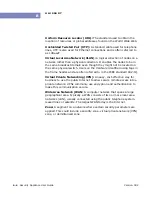
G L O S S A R Y
B-2
Security Appliance User Guide
Version 3R2
B
Default Route:
A standard entry in a routing table that enables traffic to
be forwarded for destination networks that are not explicitly defined on a
specific network device. The normal representation of the default route is
0.0.0.0/0.
Demilitarized Zone (DMZ):
Usually a small network that sits between
the trusted local area network (LAN) and the public Internet. DMZ
enables administrators to apply different polices to traffic that might
need to be accessed from the public Internet.
Domain Name:
A name that can identify one or more IP addresses.
URLs normally use domain names to identify particular web pages.
Domain Name System (DNS):
An Internet system that translates
domain names into IP addresses.
Dynamic host configuration protocol (DHCP):
Protocol that
automatically assigns IP addresses to computers on a local area network
(LAN). Typically, a system administrator designates a range of IP
addresses that DHCP assigns. Each client computer on the LAN has its
TCP/IP software configured to request an IP address from the DHCP
server. This protocol reduces the work necessary to administer a large IP
network.
Encryption:
The ability for a network device to translate data into a
secret code. Encryption is an effective way to protect data so that only
the intended recipient can decode it. All encryption uses a public/private
key pairing so that a user can encrypt and decrypt the specific data. A
device allows encryption using the private key, and only users with the
public key can decrypt that information.
Encapsulating Security Payload (ESP/AH):
Protocol that defines the
IP security used for the protocol, IP Security (IPsec). IPsec defines the
keys, algorithms and networks that are encrypted. ESP provides both
authentication and encryption, while AH or Authentication provides only
authentication. ESP is defined as protocol 50.
Ethernet:
A local area network (LAN) technology developed by Xerox
Corporation along with DEC and Intel in the 1970s. Ethernet is a best-
effort technology that uses Carrier Sense Multiple Access/ Collision
Detection (CSMA/CD) technology. Ethernet is flexible and can run over a
variety of cables including coaxial, thin coaxial, twisted pair and fiber
optic. Ethernet defines the standard for which computers connect in a
LAN segment.
Содержание freeGuard Blaze 2100
Страница 1: ...freeGuard Blaze 2100 User Guide Version 3R2...
Страница 14: ...I NT R O DU C T I O N About Document Conventions 1 4 Security Appliance User Guide Version 3R2 1...
Страница 24: ...G E T T IN G S T A R T E D Installing the freeGuard Blaze 2100 2 10 Security Appliance User Guide Version 3R2 2...
Страница 82: ...SY ST EM MA N AGEM E N T Using Traceroute 4 22 Security Appliance User Guide Version 3R2 4...
Страница 192: ...P OL IC Y CO NF I G URA T IO N About Schedules 9 28 Security Appliance User Guide Version 3R2 9...
Страница 216: ...P R E DEF I N E D SER V IC ES A 4 Security Appliance User Guide Version 3R2 A...





























